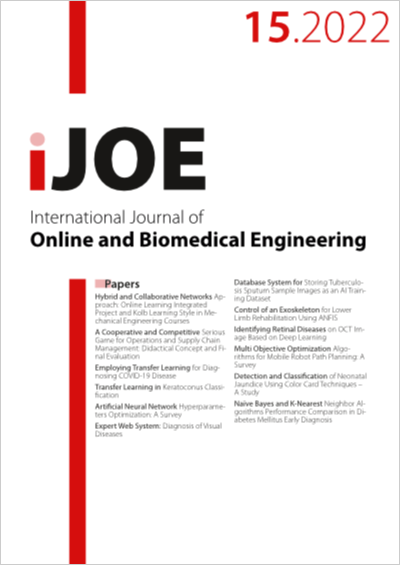Identifying Retinal Diseases on OCT Image Based on Deep Learning
DOI:
https://doi.org/10.3991/ijoe.v18i15.33639Keywords:
Artificial intelligence, deep learning, convolutional neural network, transfer learning, optical coherence tomography, DRUSEN, choroidal neovascularization, diabetic macular edemaAbstract
Computer-aided diagnosis has the potential to replace or at least support medical personnel in their everyday responsibilities such as diagnosis, therapy, and surgery. In the area of ophthalmology, artificial intelligence approaches have been incorporated in the diagnosis of the most frequent ocular disorders, such as choroidal neovascularization (CNV), diabetic macular oedema (DMO), and DRUSEN; these illnesses pose a significant risk of vision loss. Optical coherence tomography (OCT) is an imaging technology used to diagnose the aforementioned eye disorders. It enables ophthalmologists to see the back of the eye and take various slices of the retina. The goal of this research is to automate the diagnosis of retinopathy, which includes CNV, DME, and DRUSEN. The approach employed is a deep learning-based, and transfer learning technique, applying to a public dataset of OCT pictures and two pertained neural network models VGG16 and InceptionV3, which are trained on the big database "ImageNet." That allows them to be able to extract the main features of millions of images. Furthermore, fine-tuning approaches are applied to outperform the feature extraction method, by modifying the hyperparameters. The findings showed that the VGG16 model performed better in classification than the InceptionV3 architecture, with a 0.93 accuracy.
Downloads
Published
How to Cite
Issue
Section
License
Copyright (c) 2022 Abdelhafid ERRABIH, mohyeddine boussarhane, Benayad NSIRI, Abdelalim SADIQ, My Hachem EL YOUSFI ALAOUI, Rachid OULAD HAJ THAM, Brahim BENAJI

This work is licensed under a Creative Commons Attribution 4.0 International License.



